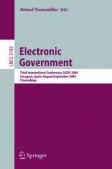Search
Search Results
-
A Dynamic Baseline Calibration Procedure for CGE models
Baseline assumptions play a crucial role in conducting consistent quantitative policy assessments for dynamic Computable General Equilibrium (CGE)...

-
Network calibration and metamodeling of a financial accelerator agent based model
We introduce a simple financially constrained production framework in which heterogeneous firms and banks maintain multiple credit connections. The...

-
Validation of a Developed Enterprise Architecture Framework for Digitalisation of Smart Cities: a Mixed-Mode Approach
To support smart cities in aligning information technology (IT) and business strategies to achieve urban digitalization, this study aims to present...

-
The Piecewise Constant/Linear Solution for Dynamic User Equilibrium
The aim of this work is to increase the precision of the solution of dynamic user equilibrium assuming that the computation takes a reasonable time...

-
Introduction
As a field of inquiry, dynamic traffic assignment (DTA) is almost always understood to mean mathematical modeling and computational methods for...
-
Conformism, distinction and heterogeneity in an agent-based model of fads
We examine the dependence of the cyclical fluctuations of demand on specific behavioral attitudes of heterogeneous agents. Starting from a modified...

-
A Science Base for Digital Governance—Why, What, and How
During the last decades, the evolution of information and communication technologies (ICTs) has offered new capabilities to citizens, businesses and...
-
Clean swee** the modelling languages jungle — Overview of commonly used modelling languages in software development, transformability, and pros and cons of model-to-model transformation
Software models are used to capture knowledge about some domain (aka problem space). In order to be useful, models should focus on a particular...
-
A chemical-reaction-optimization-based neuro-fuzzy hybrid network for stock closing price prediction
Accurate prediction of stock market behavior is a challenging issue for financial forecasting. Artificial neural networks, such as multilayer...

-
Efficient Sampling and Meta-Modeling for Computational Economic Models
Extensive exploration of simulation models comes at a high computational cost, all the more when the model involves a lot of parameters. Economists...

-
Potential Environmental Impacts of Increased Reliance on Corn-Based Bioenergy
This paper integrates economic and physical models to assess: a) how increases in agricultural commodity prices, driven by ethanol production and...
-
Sensitivity Analysis of an Agent-Based Model of Culture’s Consequences for Trade
This paper describes the analysis of an agent-based model’s sensitivity to changes in parameters that describe the agents’ cultural background,...
-
Credit Risk Analysis with a SVM-based Metamodeling Ensemble Approach
Credit risk assessment is a crucial decision for financial institutions due to high risks associated with inappropriate credit decisions that may...
-
Applying MDA Concepts in an e-Government Platform
This paper proposes an e-Government platform that intends to support legacy integration and service collaboration, at the design and run time, in...
-
Decision settings analysis – a tool for analysis and design of human activity systems
The paper describes a methodology to be used for analysis and design of human activity systems. The methodology is based on an analysis of the...
-
Modeling Nonpoint Source Pollution in an Integrated System
Nonpoint source pollution from the agricultural sector is forcing regulators to rethink national environmental and agricultural policy. Nonpoint...
-
Use of Mathematical Models in Policy Evaluation: Comments
This volume presents an informative set of applications of mathematical models to environmental policy issues. The models described in these chapters...
-
Reforming Nonpoint Pollution Policy
Depending on temperament, one can see nonpoint pollution policy as either a regulator’s worst nightmare or ultimate playground. There are multiple...
